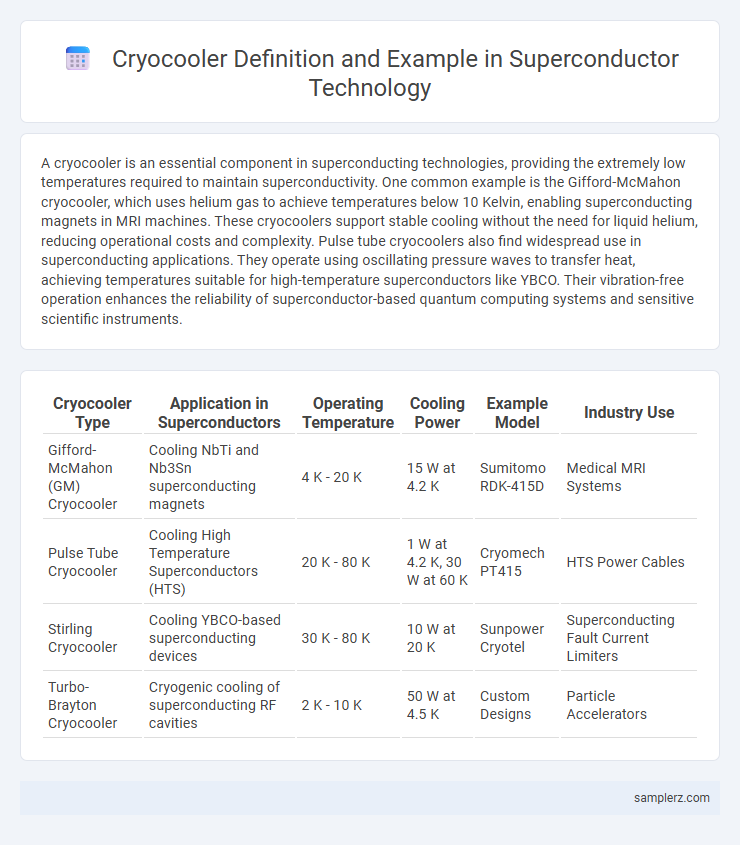A cryocooler is an essential component in superconducting technologies, providing the extremely low temperatures required to maintain superconductivity. One common example is the Gifford-McMahon cryocooler, which uses helium gas to achieve temperatures below 10 Kelvin, enabling superconducting magnets in MRI machines. These cryocoolers support stable cooling without the need for liquid helium, reducing operational costs and complexity. Pulse tube cryocoolers also find widespread use in superconducting applications. They operate using oscillating pressure waves to transfer heat, achieving temperatures suitable for high-temperature superconductors like YBCO. Their vibration-free operation enhances the reliability of superconductor-based quantum computing systems and sensitive scientific instruments.
Table of Comparison
| Cryocooler Type | Application in Superconductors | Operating Temperature | Cooling Power | Example Model | Industry Use |
|---|---|---|---|---|---|
| Gifford-McMahon (GM) Cryocooler | Cooling NbTi and Nb3Sn superconducting magnets | 4 K - 20 K | 15 W at 4.2 K | Sumitomo RDK-415D | Medical MRI Systems |
| Pulse Tube Cryocooler | Cooling High Temperature Superconductors (HTS) | 20 K - 80 K | 1 W at 4.2 K, 30 W at 60 K | Cryomech PT415 | HTS Power Cables |
| Stirling Cryocooler | Cooling YBCO-based superconducting devices | 30 K - 80 K | 10 W at 20 K | Sunpower Cryotel | Superconducting Fault Current Limiters |
| Turbo-Brayton Cryocooler | Cryogenic cooling of superconducting RF cavities | 2 K - 10 K | 50 W at 4.5 K | Custom Designs | Particle Accelerators |
Introduction to Cryocoolers in Superconductor Technology
Cryocoolers in superconductor technology are essential for maintaining the ultra-low temperatures required for superconductivity, typically below 77 K. Examples include pulse-tube cryocoolers and Gifford-McMahon cryocoolers, which provide reliable and efficient cooling for high-temperature superconductors used in MRI machines and particle accelerators. These cryocoolers enable compact and energy-efficient designs by eliminating the need for liquid helium.
Role of Cryocoolers in Superconducting Systems
Cryocoolers play a critical role in superconducting systems by maintaining temperatures near absolute zero, enabling materials to exhibit zero electrical resistance and perfect diamagnetism. Key examples include pulse tube and Gifford-McMahon cryocoolers, which provide reliable, vibration-minimized cooling for superconducting magnets in MRI machines and quantum computing devices. These cryocoolers enhance the operational stability and efficiency of superconducting components, supporting advancements in medical imaging and high-performance electronics.
Types of Cryocoolers Used for Superconductors
Cryocoolers used for superconductors primarily include Gifford-McMahon (GM), Pulse Tube, and Stirling types, each offering unique cooling efficiencies and operational features. GM cryocoolers are favored for their robust performance and ability to reach temperatures as low as 2 K, essential for many low-temperature superconducting applications. Pulse Tube cryocoolers provide vibration-free cooling, making them suitable for sensitive superconducting devices, while Stirling cryocoolers deliver compact size and high reliability, ideal for portable superconducting systems.
Gifford-McMahon Cryocooler in MRI Machines
The Gifford-McMahon cryocooler is widely used in MRI machines to maintain superconducting magnets at temperatures near 4 Kelvin, essential for stable magnetic fields. Its regenerative refrigeration cycle efficiently reduces helium gas temperature, enabling continuous, low-vibration cooling without liquid helium refills. This cryocooler enhances MRI system reliability and reduces operational costs by minimizing cryogen consumption and downtime.
Pulse Tube Cryocooler for Superconducting Quantum Devices
Pulse Tube Cryocoolers provide efficient, vibration-free cooling crucial for maintaining the superconducting state in quantum devices operating near 4 K. Their closed-cycle refrigeration system leverages oscillating gas flows without moving parts at the cold head, ensuring minimal mechanical disturbance to sensitive quantum bits. This technology enhances the stability and coherence time of superconducting qubits, advancing quantum computing performance and scalability.
Stirling Cryocoolers in Superconducting Electronic Circuits
Stirling cryocoolers are widely used in superconducting electronic circuits due to their high efficiency and compact design, enabling reliable cooling down to cryogenic temperatures essential for maintaining superconductivity. These cryocoolers utilize regenerative thermodynamic cycles to achieve temperatures as low as 20 K, supporting the stable operation of superconducting devices such as SQUIDs and quantum sensors. Their vibration reduction features are critical for preserving signal integrity in sensitive superconducting applications.
Cryocoolers for High-Temperature Superconductor Power Cables
Cryocoolers designed for high-temperature superconductor (HTS) power cables utilize pulse tube or Gifford-McMahon technologies to maintain operational temperatures around 70-90 K, essential for optimizing superconductivity and minimizing energy losses. These cryocoolers provide efficient, low-vibration cooling that supports stable current transmission in electrical grids, enhancing power capacity and reliability. Integration of advanced cryocoolers enables sustainable, scalable deployment of HTS power cables in urban and industrial power distribution networks.
Cryocooler Applications in Superconducting Magnets
Cryocoolers are essential in maintaining the low temperatures required for superconducting magnets used in MRI machines, particle accelerators, and quantum computing. These devices employ closed-cycle refrigeration technologies, such as Gifford-McMahon and pulse-tube cryocoolers, to achieve temperatures below 20 K without liquid cryogens. The reliability and efficiency of cryocoolers enable continuous operation of superconducting magnets, enhancing their performance in medical imaging and high-energy physics research.
Hybrid Cryocooler Solutions in Large-Scale Superconductors
Hybrid cryocooler solutions, combining pulse tube and Stirling cryocoolers, provide efficient and reliable cooling for large-scale superconductors used in applications like MRI machines and particle accelerators. These systems achieve temperatures below 4 K while minimizing vibrations that can disrupt superconducting stability. Optimized hybrid configurations improve energy efficiency and operational lifespan in high-field superconducting magnets.
Future Trends of Cryocoolers in Superconductor Technology
Emerging cryocooler technologies, such as pulse tube and Stirling cycle coolers, are poised to enhance the efficiency and integration of superconducting devices by achieving ultra-low temperatures with reduced vibration and power consumption. These advancements support the expansion of quantum computers, MRI systems, and fault current limiters by improving thermal management and operational stability. Research on miniaturized, high-reliability cryocoolers with adaptive control systems will further accelerate the deployment of superconducting technologies in commercial and industrial applications.

example of cryocooler in superconductor Infographic
 samplerz.com
samplerz.com